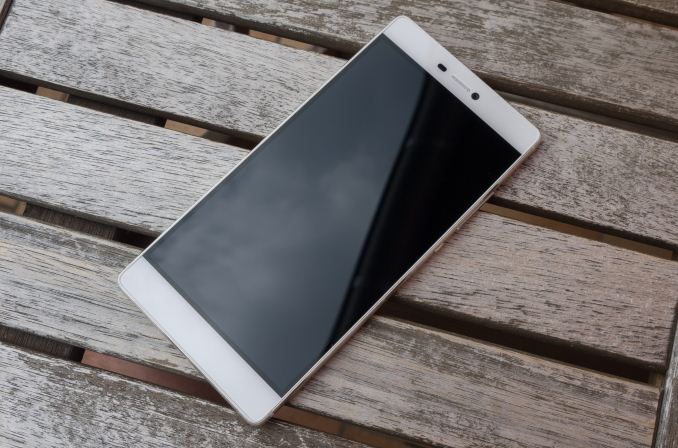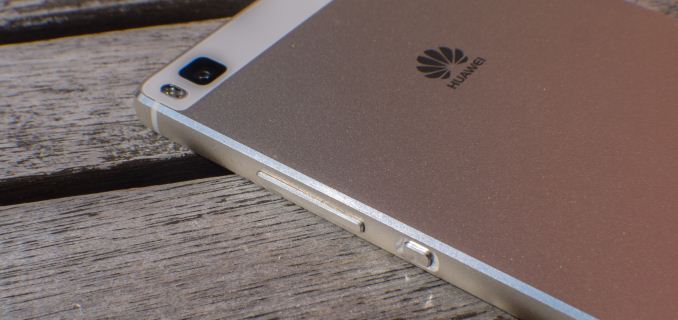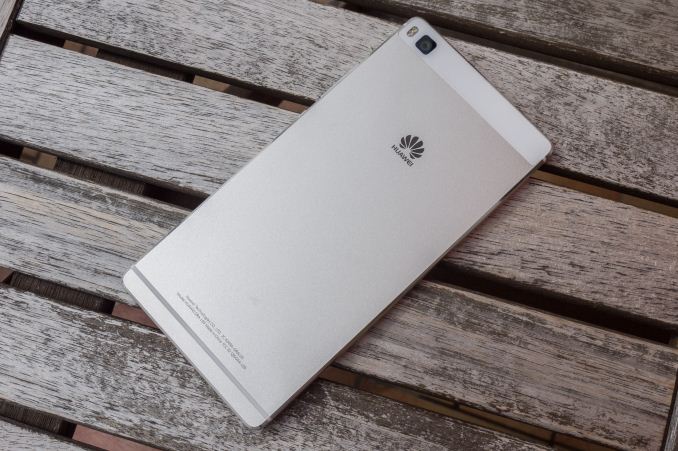The Huawei P8 Review
by Andrei Frumusanu on June 4, 2015 8:00 AM EST- Posted in
- Smartphones
- Huawei
- Mobile
- P8
- Kirin 930
Conclusion & Final Remarks
Huawei has been over the past few years trying hard to position itself among the top Android device vendors. Starting with the Mate 7 we saw the company direct itself in trying to produce more high-quality devices that try to cater to the more expensive premium segment in a bid to distance itself from some of the more notorious characteristics of Chinese-designed phones. The P8 does well here as it addresses some of the major flaws of its predecessors.
Design-wise, the P8 remains a top-notch contender as the unibody build feels both solid and is comfortable to use. I'm honestly struggling to find any major objective faults with the device that would make me say that it might be problematic in every-day usage. I just hope that the P8's metal back and new finish is more scratch resistant than the Mate 7's, as my unit already exhibits quite a few battle scars on the smooth metal finish.
The screen of the P8 also has its strengths - I really hope that Huawei keeps a discrete user setting that acts as a calibrated accurate display profile, as it was a pleasant surprise to see the P8 exceed our expectations in that metric. The 5.2" size remains manageable, and with a resolution of 1080P the P8 doesn't try to compete in the resolution race. While I'm not sure if my unit was a one-off case or if it's a common production problem, it's imperative that Huawei tries to improve its quality control for displays. The extensive backlight bleed I had on one corner of my review unit is certainly severe enough to try to get a replacement unit under warranty.
One of the major flaws of the last few Huawei devices was their use of in-house Kirin SoCs: I regard the Kirin 920 as quite of an embarassement in terms of power efficiency and a major Achilles' Heel in terms of battery life for whenever one would run CPU-intenstive tasks such as website rendering / extensive browsing. The Kirin 930 keeps itself limited to less powerful A53 cores more out of pure necessity rather than concious choice. This, together with an actual smart thermal budget mechanism in the form of ARM's IPA prevents the P8 from ending up with the same melt-down scenarios we experienced on the Mate 7. While the Kirin 930 makes the CPU "good enough", that's about as much positive as there is to say about the chipset, as it still remains a relatively inefficient SoC with one of the worst GPU performances we've enountered this generation. I've said this in the Mate 7 review and I will keep being frank with the P8 as well: This would have been a much better phone had Huawei chosen to employ a third-party SoC such as from Qualcomm, MediaTek or Samsung.
While the P8's 2680mAh battery manages to deliver acceptable to average lifetime, one has to consider that the Huawei pays the performance price to reach those numbers. As such, one can't really consider the P8 an efficient device as the performance per Watt is below other devices. There's also the fact that the promised fast-charging capability just never materialized, and the P8 exhibited itself as one of the slowest charging phones out there even though it has a smaller battery capacity.
The second major flaw that was addressed in the P8 is the camera performance. The inclusion of a new innovative camera sensor and OIS, all powered by a dedicated external ISP makes P8 leaps and bounds more capable than what we saw in the Mate 7 - there's no contest as Huawei delivered substantial improvements in picture quality. While in daylight, the P8 still couldn't quite match top performers such as the Galaxy S6 and equivalent, it's in the low-light scenarios where the new Sony IMX278 RGBW sensor is able to shine. I'm still holding off declaring this the best low-light shooter available before we publish our LG G4 review, but the P8 was able to consistently outperform the previous record-holder, the Galaxy S6.
It's just a pity that while we can now consider Huawei among the vendors with top-performing camera hardware, that we also see it being held back by a hard to use software interface that, while acceptable for previous models, is no longer worthy of such a high-end shooter. I hope that Huawei (And every other vendor for that matter) is paying close attention to the competition when it comes the camera application, as over the last few months we've seen the bar being raised to new heights on more than one occasion.
While we're still talking about hardware, it's just baffling to see Huawei implement such bad WiFi connectivity for the third time in a row. Not only does the P8 yet again disappoint in WiFi reception and speeds, it actually even sees a downgrade capability by dropping support for the 5GHz band. For people who live in areas crowded 2.4GHz spectrum, this can be extremely worrisome as connectivity will undoubtedly suffer.
On the software side, other than a few kinks such as the subjectively unintuitive multi-task menu or the nagging power consumption notifications, there's little to critique EmotionUI 3.1. I had big praises for EmUI on the Mate 7, and while the P8 removed one of those core elements (Per-app permission manager) that made it so notable, it remains an extremely solid OEM modification of Android. Design-wise, Huawei even improved on it as we see a return of more colourful icons throughout the OS which give the interface a rather pleasing and clean look.
Yet again we find ourself at the end of the review with probably the most important question of them all: Is the P8 worth buying? At official MSRPs of 499€ and 599€ for respectively the 16GB and 64GB versions, I'd say no. The P8 just seems to have too many compromises to be able to be considered as a viable alternative to other devices at that price range. While the camera is the phone's truly outstanding feature, the whole device as a package just seems to underperform on too many other areas to be able to justify a purchase. Buying last year's flagship devices from vendors such as LG, HTC and Samsung can already be a lot cheaper than getting the P8, and one will probably end up with a better device than what Huawei managed to offer this generation.
Nevertheless, one has to acknowledge that Huawei managed to make huge strides with the P8. It's clear that the company is trying to improve its weaknesses one at a time, as we saw the use of a much more reasonable SoC, better NAND performance, and a great camera on the P8. I just hope that in future models Huawei addresses faults with the WiFi connectivity, and maybe with help of a 16nm manufacturing process, manages to employ a Kirin SoC that is truly competitive both in performance and efficiency. That would be a truly interesting device to review!













104 Comments
View All Comments
hrrmph - Thursday, June 4, 2015 - link
It's probably more useful than an iPhone for people who travel a lot and occasionally go off the grid, and thus need the device to still work as a GPS, camera, miniature computer, etc, while drawing all data from fast, convenient local storage...- It has a MicroSDXC slot, so it can take the new 200GB MicroSD storage cards; and
- It has dual SIMS.
Unfortunately, it lacks a user removable battery, so it is still inferior in that regard to each of the phones and phablets that I already have. But, in general, I like what they are doing.
Something that other nationals can tend to forget is that China has a lot of wealthy people (far more than the US or possibly even Europe). Even though these elite Chinese are wealthy, many of them are shrewd spenders. They want value for their high-end spend. So there is a lot of pressure on Chinese vendors to produce high-end devices that include every possible feature.
So just like Japanese enthusiasts used to get certain stereos and cameras that America only dreamed of, the Chinese are demanding that the manufacturers provide more fully functional high-end phones that can do everything... including the things that the iPhone cannot do.
That said, the iPhone is making headway in China too...
... but just like in the US, it's for all the wrong reasons. Namely, it's a jewelry piece that holds sway as a status symbol amongst the more vacuous of minds. Owning one supposedly elevates your perceived social status - much in the way that owning a ludicrously expensive sports car or ultra-luxury car does the same (think Rolls-Royce, Bentley, etc.).
Sociologists and psychologists have hypothesized that such objects are attractive to both the buyers who display them publicly and to those who view them, particularly the opposite sex.
People who buy these objects are subliminally advertising to potential mates that they have excess money that (under the proper circumstances) can in the future be re-directed to caring and tending for children and non-working spouses.
The attraction effect is generally stronger if the object is purchased and displayed by a male, because many societies still expect the male to bear the larger burden of providing financial resources. This is especially the case while the female is pregnant and in the early years of caring for children that aren't yet school aged.
The larger the excess spend over the practical value, the higher the perception of excess earning capacity. That's why we sometimes see phones sold with precious jewels encrusting them. Apple is just doing the same thing on a lower level... right out of the box. Charging more than the inherent underlying value.
So it's rather refreshing to see the Chinese manufacturers taking a different approach.
And it is especially refreshing to see the Chinese doing this in light of the fact that Samsung vacated the market as an Apple competitor and have now lowered themselves to merely matching Apple's product features. Without the Chinese, the Apple-Samsung twins (newly conjoined) don't really have any competition. The Chinese upping their game changes things.
Of course Apple can play this game too if they want. They simply need to offer more than 264GB of storage. The P8's 64GB of onboard NAND storage combined with the new SanDisk 200GB Micro-SDXC storage card will now set a very high bar that Apple needs to try to hurdle over (if Apple wants to be taken seriously with regard to storage).
I'm thinking that if Apple offers its next phone with 512GB of storage then that would safely secure the storage crown for them (remember, Samsung used to regularly double Apple's storage by simply adding a Micro-SD slot, but Samsung has now given up on competing).
Then Apple would need to add Dual-SIM slots to improve connectivity and travelability. It may come as a surprise to the uninformed that the newly wealthy Chinese (like many other nationals) are joining the tourist-corps. They are world travelers and they want their phones to work anywhere that they are likely to travel. Having Dual-SIMs makes it both convenient and affordable (roaming data charges are still the bane of the planet, even for wealthy Chinese).
I would also argue that to be better than what I've personally already got (and most Chinese, other Asians, Middle-Easterners, Africans, and Europeans already have), Apple would need to offer user removable back covers and batteries. Nothing says "I can handle a thirty hour multiple segment, multi-modal (air, sea, and land) journey" than a couple of lightweight fully-charged spare batteries. No awkward cables... just plop in and play on like nobody's watching.
So the Chinese phones are Apple clones? Nahh, this is just the Chinese practicing for the end-game. They want to do what Samsung used to regularly do to Apple: offer the consumer more for less... and the Chinese have just proven that they can win the storage crown. So who is to say they won't eventually win the various other races to provide the best-of-the-best on the other features? All it requires is Apple-Sung to remain lazy… which is something they have lately proven to be very adept at.
pityko - Thursday, June 4, 2015 - link
I signed up just to be able to thank you for this comment. You brilliantly summarised everything that's wrong with the current "leaders" of the mobile phone industry. I've been a Samsung user for years after being disappointed by the iPhone 3G then HTC in general but now when my contract expires for my Note 3 I am leaving for a Chinese brand, I want to support a company that hasn't given up trying.pgari - Thursday, June 4, 2015 - link
Always surprises me how people in these blogs write about what Apple "should do", but for what? To be even more successful? What are their credentials?Of course, anyone can say what they like or dislike. But the implicit assumption in most of these comments is "I know better", which is, at the least, presumptuous
Rod_Serling_Lives - Friday, June 5, 2015 - link
Well said. Apple already dominates with only a handful of devices and I don't know if they could be in a better position than they are currently.nathanddrews - Friday, June 5, 2015 - link
Personally, I don't like anything about Apple except the build quality of most of its products and its stock price. Cha-ching! I don't buy Apple products or use Apple software, but I'm happy the corporation is so successful. Deep down inside, I find myself horribly judging and mocking consumers of Apple products, but then I just have to remind myself not to feel bad about it. They're already dead inside.;-)
Brakken - Friday, June 5, 2015 - link
I think it's Tall Poppy syndrome... even ignoring everything else Apple has pioneered over the years and just looking at the Apple Watch - first gen of hardware and software, and it's amazingly smooth and will have years of support and development. With the hardware makers for Android, they are all dropping support for SD cards and removable batteries, except LG (?), but no one seems to talk about it when it happens. I think people start making 'I know better' statements because they don't check history.MarcSP - Saturday, June 6, 2015 - link
I agree with many of the things you said, but your theory about iphone as a status symbol is incomplete. I mean, according to what you said it seems that most buyers should be single men, and I have seen as many women as men with iPhone in Shanghai (maybe more, as female tend to follow fashion very strongly, and most cannot choose a phone based on "tech" or "features").Also, many married couples and middle aged and old persons use iPhone. Even students have them.
It always strikes me, because in China iPhone's price is quite higher than the average salary in the first tier cities. Imagine if an iPhone cost 2000 USD in the US. Nobody would buy it, but in china they do.
I guess mostly because the "status symbol" thing, but not to impress potential sexual partners, just to say "hey, look, I am NOT POOR", even if you are and cannot afford a health insurance and use recycled oil for cooking. After the communist times, Chinese socity has gone to the other extreme. Now being poor is not just pityful, it is shameful. No matter how, even if you have to sell tainted milk to babies or steal from your fellow citizens with lies, you MUST become rich. Of course, most cannot, so that's why they think having a "symbol" is better than nothing. "Appearence" is king nowadays in China, not "substance". I guess they need 20 more years to find a balance. Too many changes, too fast.
Ethos Evoss - Friday, June 12, 2015 - link
jesu su writing a book ?jjj - Thursday, June 4, 2015 - link
You wish the iphone had a sane design like this instead of their roadkill look.puremind - Thursday, June 4, 2015 - link
If Apple had cloned this device, it would have been better. Instead of the huge bezels it would have had a much more usable form factor.